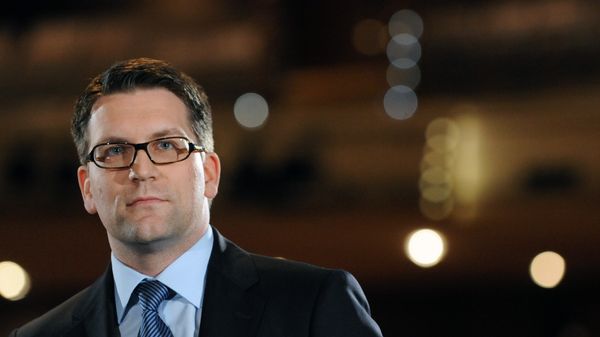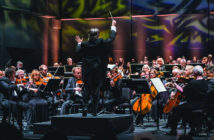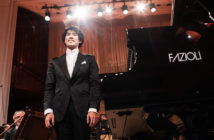It is official. Alexander Neef, general director of the Canadian Opera Company, will take the reins of the Paris Opera in September, a year ahead of schedule.
Well, Alexander, bon voyage. That’s French for “good riddance.” The needs of the COC are obviously acute in the era of COVID-19, but the company will probably fare better without a chronic underachiever in the executive suite.
For the sake of appearances Neef will hold on to the Toronto title while he settles into his Paris quarters. “Being able to minimize air travel remains the safest course of action for my family right now,” was the explanation trotted out in the press release.
“We are deeply appreciative of [Neef’s] unwavering dedication to the COC and are confident he will excel in leading both companies forward until his successor is fully on board,” said COC chairman Jonathan Morgan in this statement, offering evidence, if any were needed, that we live in an age of malleable truth.
Unwavering dedication. This of a general director who took a summer job in 2018 as artistic director of the Santa Fe Opera. This of a general director who negotiated a sweetheart contract that had him in Toronto until 2026.
Neef was not a disaster in every respect. The former casting director in Paris under the late Gérard Mortier brought this skill (and this skill only) to Toronto in 2008. He had his favourites, which were not always mine, but he could assemble a decent squad of singers to staff an otherwise ghastly production of The Marriage of Figaro or Die Fledermaus.
Not that it took a PhD to recognize the usefulness of soprano Sondra Radvanovsky, who lives in the GTA, as an exponent of the diva repertoire, or the potential popularity of local hero Russell Braun even in roles a shade too weighty for his lyric baritone.
Convincing the American dramatic soprano Christine Goerke to try out big sings in Toronto before unleashing them at the Met was not a bad thing to do, even if it did confirm the status of the COC (misidentified in Paris Match last year as “L’Opéra de Toronto”) as a stepping stone rather than a destination house.
In short, Neef has kept the vocal quality reasonably high (not least in the COC Ensemble) while maintaining an appropriate balance of foreign and domestic talent. And if his choice of another German, Johannes Debus, as music director showed a certain trans-Atlantic chutzpah, the balance of reliable reviews (by which I mean those written by myself) are favorably disposed to Debus as a conductor.
What Neef failed to do spectacularly is build an audience. It is a failure that one might attribute to the vagaries of the economy, the advent of livestreaming, the price of parking or any number of standard-issue excuses that have potential validity anywhere. But there is a central and specific explanation for the underperformance of the COC: a parade of supposedly innovative productions that required a manifesto from the stage director to understand and a six-pack of Red Bull to sit through.
To some readers this conclusion might appear to be just a little tainted by personal opinion, so let us look at the numbers, some of them represented in a helpful article published in 2019 by Ludwig van Toronto. In 2014-15 Neef cut back the COC season from seven mainstage productions to six (one of these being a double bill). He did this despite the company’s residency at the Four Seasons Centre, a beautiful house at a perfect downtown intersection with excellent subway access in a metropolis that was deemed to have surpassed Chicago in size by population.
Now, the preeminent company of that American city has had its problems, including a strike in 2018. Nevertheless, in a non-pandemic season, the Lyric Opera of Chicago mounts eight mainstage productions plus a long postseason run of a quality musical (last year, West Side Story) and two performances of a chamber opera on a smaller stage.
In terms of capacity, the Civic Opera House, after a renovation now in progress, will clock in at 3,276 seats, compared to 2,071 at the Four Seasons Centre. It is a distinction worth keeping in mind when the COC announces what appear to be tolerably high attendance percentages. Ninety percent in a facility as compact as the Four Seasons Centre is nothing to crow about.
Especially when you consider the numbers the COC itself posted in 2008-09, a season booked substantially by former COC general director Richard Bradshaw (1944-2007). Back then, 99% crowds turned up to 64 performances (as opposed to 48 performances in 2018-19). One might argue that the Four Seasons Centre in 2008 was still a novelty, but so too was the financial crisis.
Since the middle of the ensuing decade the bottom line has sunk steadily. From 2014-15 to 2018-19 ticket sales plunged from 105,086 to 82,199. Average attendance dropped from 92% to 86%. Remember, attendance percentage should rise as performances decrease.
Subscriptions, the lifeblood of any big performing-arts company, dropped from 63,603 tickets in 2014-15 to 48,214 tickets in 2018-19. This trajectory can be explained somewhat by a drift from subscription to single-ticket purchases. Still, overall ticket revenue was down from $9.4 million to $8 million. This is a substantial decline that a real CEO reporting to a real board of directors would be hard pressed to explain.
It might be objected that live performance is under pressure in an increasingly digital world. Even before COVID-19 stimulated a global acceleration of online activity, the 2010s were notable for the expansion of opera into the cinema through the Metropolitan Opera Live in HD phenomenon, into the living room through YouTube and other platforms and even onto tablets through streaming.
Neef has done little to take advantage of this trend. Indeed, his most notable contribution to the evolution of public access in 2012 was to fail to reach an agreement with the COC Orchestra that would have kept Toronto productions on the docket of Saturday Afternoon at the Opera, the CBC standby that carries the Metropolitan Opera radio broadcast season and constitutes a significant unifying force among Canadian opera lovers.
If all the mediocrity in metrics came about in spite of season after season of artistic splendour, it might be possible to characterize Neef as a European visionary whose ideas were too advanced for the sprawling North American backwater in which he found himself. Indeed, such a narrative is probably taking shape in certain quarters. In reality, Neef’s taste for modern dress and gratuitous directorial glosses created a sequence of pretentious flops that might be easy to write off in a state-supported European house (where booing on opening night can be construed as a sign of success) but are deadly to a company that operates on a precarious mix of box office, philanthropy, goodwill and government grants.
Even those who stroked their chins thoughtfully at the appearance of Sumo wrestlers in Handel’s Semele or the use of a telephone by the title character in Mozart’s La Clemenza di Tito were sometimes moved to question the record of this nominally national company as a producer of Canadian opera. The only full-length mainstage Canadian works to which Neef gave the green light were Rufus Wainwright’s Hadrian, which could not possibly have failed to attract an audience, and Harry Somers’s Louis Riel, a proven classic which the COC presented as a co-production with the National Arts Centre. (Barbara Monk Feldman’s minimalist Pyramus and Thisbe in 2015 lasted 50 minutes.)
I could continue, but it is possible to pile on, even by yourself. The point is to learn from the Neef years and restart a company with an honourable history, a wonderful house and a huge potential market. The search for a successor has begun. This individual will have much to repair and much to restore when the pandemic subsides. At least there is a clear blueprint of how not to move forward.













